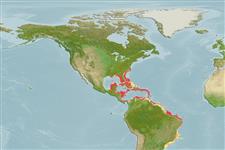Common names from other countries
Environment: milieu / climate zone / depth range / distribution range
Ecologie
marien rifbewoner; diepte 2 - 137 m (Ref. 5222), usually 5 - 35 m (Ref. 40849). Subtropical; 35°N - 28°S, 92°W - 33°W (Ref. 5222)
Western Atlantic: Bermuda, Gulf of Mexico and the Caribbean south to Sao Paulo, Brazil.
Lengte bij maturiteit / Grootte / Gewicht / Leeftijd
Maturity: Lm 53.6, range 50 - 63 cm
Max length : 100.0 cm TL mannelijk / geslacht onbekend; (Ref. 26340); common length : 50.0 cm TL mannelijk / geslacht onbekend; (Ref. 5217); max. gepubliceerd gewicht: 18.5 kg (Ref. 40637)
Dorsale stekels (totaal) : 11; Dorsale zachte stralen (totaal) : 15 - 16; Anale stekels: 3; Anale zachte stralen: 10 - 12. Distinguished by the following characteristics: Head and body have oval groups of dark spots; outer third of pectoral fin bright yellow (Ref. 26938); two color morphs: a deep-water reddish form and shallow-water greenish form; depth of body contained 2.9-3.2 times in SL; head length 2.6-2.9 times in SL; convex interorbital area; evenly rounded preopercle or with slight notch, without projecting bony lobe at the angle; nostrils subequal or posterior nostrils with diameter twice the size of anterior nostrils (Ref. 89707).
Adults found on rocky and coral reefs, juveniles occur in shallow turtle grass beds. Also been taken in trawls over mud bottom in the northern Gulf of Mexico. Feeds mainly on fishes (mostly on coral reef species) and squids. Although often implicated in ciguatera poisonings, it is a desirable food fish; and even large (5 to 10 kg) fish from areas considered safe are sold in markets. Also caught with surface trolling. Sex-reversal has been observed (Ref. 5521).
Heemstra, P.C. and J.E. Randall, 1993. FAO Species Catalogue. Vol. 16. Groupers of the world (family Serranidae, subfamily Epinephelinae). An annotated and illustrated catalogue of the grouper, rockcod, hind, coral grouper and lyretail species known to date. Rome: FAO. FAO Fish. Synop. 125(16):382 p. (Ref. 5222)
Status op de Rode Lijst van het IUCN (Ref. 130435)
CITES (Ref. 128078)
Not Evaluated
Gevaar voor de mens
Reports of ciguatera poisoning (Ref. 4690)
Gebruik door de mens
Visserij: van groot commercieel belang; sportvis: ja; Aquarium: Publieke aquaria
Tools
Speciale rapporten
Download XML
Internetbronnen
Estimates based on models
Preferred temperature (Ref.
115969): 24.3 - 28, mean 27 (based on 310 cells).
Fylogenetische diversiteitsindex (Ref.
82804): PD
50 = 0.5000 [Uniqueness, from 0.5 = low to 2.0 = high].
Bayesian length-weight: a=0.01122 (0.00720 - 0.01748), b=3.04 (2.92 - 3.16), in cm Total Length, based on LWR estimates for this species & Genus-body shape (Ref.
93245).
Trofisch niveau (Ref.
69278): 4.5 ±0.5 se; based on diet studies.
Weerstandsvermogen (Ref.
120179): laag, minimale populatieverdubbelingstijd 4,5-14 jaar (K=0.09-0.17; tmax=15; Fec=400,000).
Fishing Vulnerability (Ref.
59153): High vulnerability (62 of 100).
Climate Vulnerability (Ref.
125649): Very high vulnerability (86 of 100).
